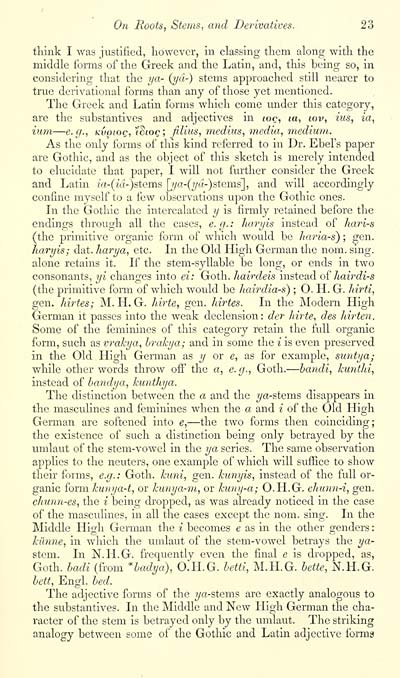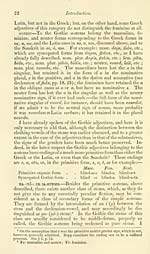Blair Collection > Celtic studies
(53)
Download files
Complete book:
Individual page:
Thumbnail gallery: Grid view | List view

On Roots, Steins, and Derivatives. 23
think I was justified, however, in classing them along with the
middle forms of the Greek and the Latin, and, this being so, in
considering that the ya- (yd-) stems approached still nearer to
true derivational forms tlian any of those yet mentioned.
The Greek and Latin forms which come vmder this category,
are the substantives and adjectives in tog, m, lov, ius, ia,
turn — e.g., Kvpiog, ISiog; filius, medius, media, medium.
As the only forms of this kind referred to in Dr, Ebel's paper
arc Gothic, and as the object of this sketch is merely intended
to elucidate that paper, I will not further consider the Greek
and Latin ?"a-(ia-)stems [j/a-(t/a-) stems], and will accordingly
confine myself to a few observations upon the Gothic ones.
In the Gothic the intercalated y is firmly retained before the
endings through all the cases, e.g.: haryis instead of hari-s
(the primitive organic form of which would be haria-s) ; gen,
haryis; dat. harya, etc. In the Old High German the nom. sing,
alone retains it. If the stem-syllable be long, or ends in two
consonants, yi changes into ei: Goth, hairdeis instead o? hairdi-s
(the primitive form of which would be hairdia-s) ; O. H. G. hirti,
gen. hirtes; M. H. G. hirte, gen. hirtes. In the Modern High
German it passes into the weak declension: der hirte, des hirten.
Some of the feminines of this category retain the full organic
form, such as vrakya, braky a; and in some the i is even preserved
in the Old High German as y or e, as for example, suntya;
while other words throw ofi" the a, e.g., Goth. — handi, kunthi,
instead of handya, kiinthya.
The distinction between the a and the ya-stems disappears in
the masculines and feminines when the a and i of the Old High
German are softened into e, — the two forms then coinciding;
the existence of such a distinction being only betrayed by the
umlaut of the stem-vowel in the ya series. The same observation
applies to the neuters, one example of which will suffice to show
their forms, e.g.: Goth, kuni, gen. kitnyis, instead of the full or-
ganic form kunya-t, or kimya-m, or kuny-a; O.H.G. chunn-i, gen.
chunn-es, the i being dropped, as was already noticed in the case
of the masculines, in all the cases except the nom. sing. In the
Middle High German the i becomes e as in the other genders :
ki'inne, in which the umlaut of the stem-vowel betrays the ya-
stem. In N.H.G. frequently even the final e is dropped, as,
Goth, hadi (from *hadya), O.H.G. hetti, M.H.G. lette, N.H.G.
Lett, Engl. hed.
The adjective forms of the ?/a-stems are exactly analogous to
the substantives. In the Middle and New High German the cha-
racter of the stem is betrayed only by the umlaut. The striking
analogy between some of the Gothic and Latin adjective forma
think I was justified, however, in classing them along with the
middle forms of the Greek and the Latin, and, this being so, in
considering that the ya- (yd-) stems approached still nearer to
true derivational forms tlian any of those yet mentioned.
The Greek and Latin forms which come vmder this category,
are the substantives and adjectives in tog, m, lov, ius, ia,
turn — e.g., Kvpiog, ISiog; filius, medius, media, medium.
As the only forms of this kind referred to in Dr, Ebel's paper
arc Gothic, and as the object of this sketch is merely intended
to elucidate that paper, I will not further consider the Greek
and Latin ?"a-(ia-)stems [j/a-(t/a-) stems], and will accordingly
confine myself to a few observations upon the Gothic ones.
In the Gothic the intercalated y is firmly retained before the
endings through all the cases, e.g.: haryis instead of hari-s
(the primitive organic form of which would be haria-s) ; gen,
haryis; dat. harya, etc. In the Old High German the nom. sing,
alone retains it. If the stem-syllable be long, or ends in two
consonants, yi changes into ei: Goth, hairdeis instead o? hairdi-s
(the primitive form of which would be hairdia-s) ; O. H. G. hirti,
gen. hirtes; M. H. G. hirte, gen. hirtes. In the Modern High
German it passes into the weak declension: der hirte, des hirten.
Some of the feminines of this category retain the full organic
form, such as vrakya, braky a; and in some the i is even preserved
in the Old High German as y or e, as for example, suntya;
while other words throw ofi" the a, e.g., Goth. — handi, kunthi,
instead of handya, kiinthya.
The distinction between the a and the ya-stems disappears in
the masculines and feminines when the a and i of the Old High
German are softened into e, — the two forms then coinciding;
the existence of such a distinction being only betrayed by the
umlaut of the stem-vowel in the ya series. The same observation
applies to the neuters, one example of which will suffice to show
their forms, e.g.: Goth, kuni, gen. kitnyis, instead of the full or-
ganic form kunya-t, or kimya-m, or kuny-a; O.H.G. chunn-i, gen.
chunn-es, the i being dropped, as was already noticed in the case
of the masculines, in all the cases except the nom. sing. In the
Middle High German the i becomes e as in the other genders :
ki'inne, in which the umlaut of the stem-vowel betrays the ya-
stem. In N.H.G. frequently even the final e is dropped, as,
Goth, hadi (from *hadya), O.H.G. hetti, M.H.G. lette, N.H.G.
Lett, Engl. hed.
The adjective forms of the ?/a-stems are exactly analogous to
the substantives. In the Middle and New High German the cha-
racter of the stem is betrayed only by the umlaut. The striking
analogy between some of the Gothic and Latin adjective forma
Set display mode to: Large image | Transcription
Images and transcriptions on this page, including medium image downloads, may be used under the Creative Commons Attribution 4.0 International Licence unless otherwise stated. ![]()
| Early Gaelic Book Collections > Blair Collection > Celtic studies > (53) |
|---|
| Permanent URL | https://digital.nls.uk/75771765 |
|---|
| Description | A selection of books from a collection of more than 500 titles, mostly on religious and literary topics. Also includes some material dealing with other Celtic languages and societies. Collection created towards the end of the 19th century by Lady Evelyn Stewart Murray. |
|---|
| Description | Selected items from five 'Special and Named Printed Collections'. Includes books in Gaelic and other Celtic languages, works about the Gaels, their languages, literature, culture and history. |
|---|

